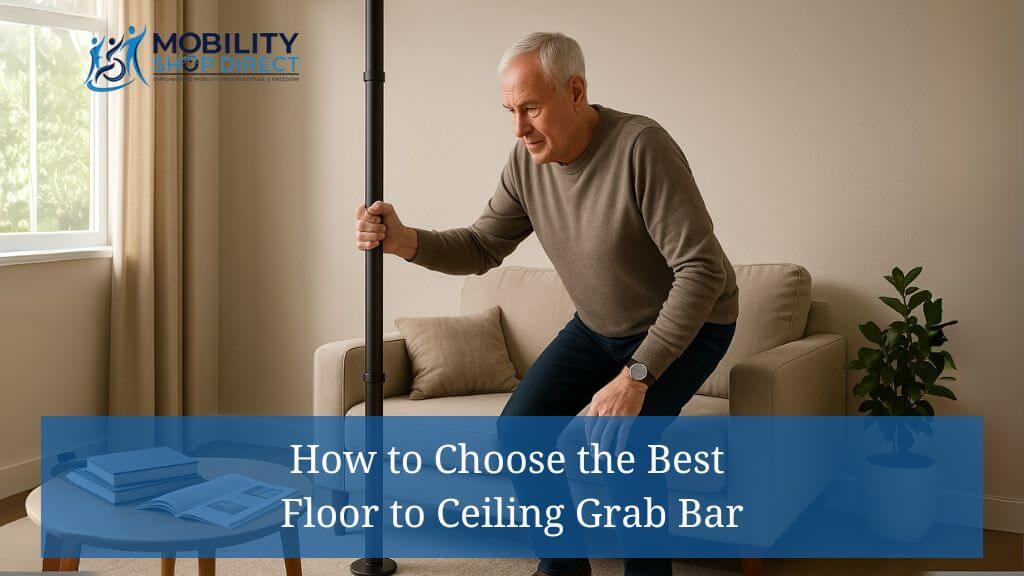Choosing the right floor-to-ceiling grab bar isn’t just about safety. It’s also about making daily movement easier, supporting independence, and creating a space that works for everyone. Whether you’re recovering from an injury, helping a family member, or just planning ahead, picking the right grab bar takes a bit of thought.
This guide breaks down the key things to look for such as adjustable height, weight capacity, and how it fits different surfaces. We’ll also look at the differences between tension-mounted and permanent bars, as well as options made for bathrooms or shared spaces. By the end, you’ll be ready to pick a setup that works for your needs.
Let’s get into it.
Table of Contents
- What Are Floor to Ceiling Grab Bars?
- Types of Floor to Ceiling Grab Bars
- How to Choose the Best Floor to Ceiling Grab Bar
- Key Features to Look for When Buying
- Installation and Maintenance Tips
- FAQs About Floor to Ceiling Grab Bars
- Key Takeaways
- Conclusion
What Are Floor to Ceiling Grab Bars?
Definition and Purpose of Floor to Ceiling Grab Bars
Floor-to-ceiling grab bars are vertical poles designed to help with balance, movement, and support. They run from the floor to the ceiling and give users something stable to hold onto while moving around. They’re especially helpful for people with limited mobility, seniors, or anyone recovering from surgery.
They don’t just prevent falls, they give people more control over their daily routines. With a well-placed grab bar, simple actions like standing up or shifting positions get easier and safer.
Common Applications of Floor to Ceiling Grab Bars
These grab bars are useful in different parts of the house:
- Bathroom Safety: A floor-to-ceiling grab bar near a toilet or shower can prevent slips in one of the most accident-prone areas of the home.
- Transfers: They make it easier to move from a wheelchair to a bed or from a chair to standing.
- Living Areas: Some people place them in hallways, kitchens, or entryways to steady themselves while moving around the home.
Types of Floor to Ceiling Grab Bars
Tension-Mounted vs. Permanent Grab Bars
You’ll find two main types of grab bars:
- Tension-Mounted: These don’t require screws or drilling. They use pressure to stay in place and are great for renters or anyone who needs flexibility. They’re easy to move but may not be as sturdy in high-use areas.
- Permanent: These get screwed into the floor and ceiling for maximum support. They’re the best choice for long-term use, especially in spots like the bathroom. Just keep in mind, installation might need a pro.
Specialized Designs for Different Needs
Some grab bars are made for specific conditions:
- Shower-Safe Models: Made with water-resistant materials like stainless steel, these are perfect for wet areas.
- General Use Bars: These work well in living rooms, bedrooms, or kitchens.
- Adjustable or Compact Versions: Great for small spaces or ceilings with unusual heights. Some even fold down when not in use.
How to Choose the Best Floor to Ceiling Grab Bar
Matching the Ceiling Height
Grab bars need to fit your ceiling. Most adjustable models can handle ceilings up to 10 feet. Just be sure to measure first so you’re not surprised during installation.
Evaluating Weight Capacity
Look for bars that can support at least 113–136 kg. For people who need more support or heavier use, there are high-capacity options rated for up to 181 kg or more. If you're unsure, this guide on choosing safe bedside rails offers similar considerations for weight and support needs.
Selecting the Right Mounting System
- Need something temporary? Go with tension-mounted bars.
- Want something permanent? A bolted bar is the way to go, especially in bathrooms or long-term care situations.
Confirming Floor and Ceiling Surface Compatibility
Make sure the bar works with your floor and ceiling material. For tile, carpet, or textured surfaces, some bars may need extra grip or even professional installation. You can learn more about setup challenges in this install guide for floor-to-ceiling grab bars.
Considering Room-Specific Uses
Pick a bar that fits the room. For bathrooms, water-resistant materials are key. For living areas, a sleek design helps it blend in. You can also browse options by room in the floor-to-ceiling grab bar collection.
Key Features to Look for When Buying
Safety Certifications and Compliance
Look for ADA-compliant products or other safety certifications. These show the product meets tested standards. Warranty and return policies are also worth checking.
Adjustable vs. Standard Floor to Ceiling Grab Bars
Adjustable models work better for flexible spaces or evolving needs. If you only need it for one place, a standard model might offer more stability.
Material and Durability Considerations
Stainless steel or powder-coated aluminum resists wear and corrosion. If durability is a top concern, learn what materials stand up best in this guide on over-bed poles.
Installation and Maintenance Tips
Installing Tension-Mounted Grab Bars
- Place it where you want it and adjust the pressure. Don’t overtighten.
- Make sure it’s standing straight and feels solid.
Installing Permanent Grab Bars
- Use a power drill and sturdy hardware to anchor it properly.
- On tricky surfaces, call a professional for extra security.
Maintaining and Cleaning Your Floor to Ceiling Grab Bar
- Clean with mild soap and water regularly.
- Check for loosened parts or rust. Fix or replace if needed.
FAQs About Floor to Ceiling Grab Bars
What Ceiling Height Do I Need?
Most models adjust up to 10 feet (3 m) Measure your space first to be sure.
How Much Weight Can It Support?
Most are rated for 113–136 kg. Heavy-duty options go higher.
Can They Be Installed on Any Floor?
Yes, but uneven or textured floors might need extra support or expert installation.
Key Takeaways
- Measure your ceiling before buying; most bars fit ceilings up to 10 feet (3m)
- Check weight limits and choose a bar that matches your needs.
- Tension-mounted bars are easier to move. Permanent ones are sturdier.
- Match the bar to your flooring and ceiling type for best stability.
- Pick a design that fits the room and your day-to-day routine.
Conclusion
Floor-to-ceiling grab bars make life easier and safer for anyone who needs support at home. With the right features and proper setup, they can reduce fall risk and make everyday movements more manageable.
If you're choosing one for yourself or a loved one, focus on the details; height, surface compatibility, material, and weight capacity. A bit of planning upfront makes a big difference later.
And remember, the right grab bar isn’t just a support tool; it’s peace of mind.



